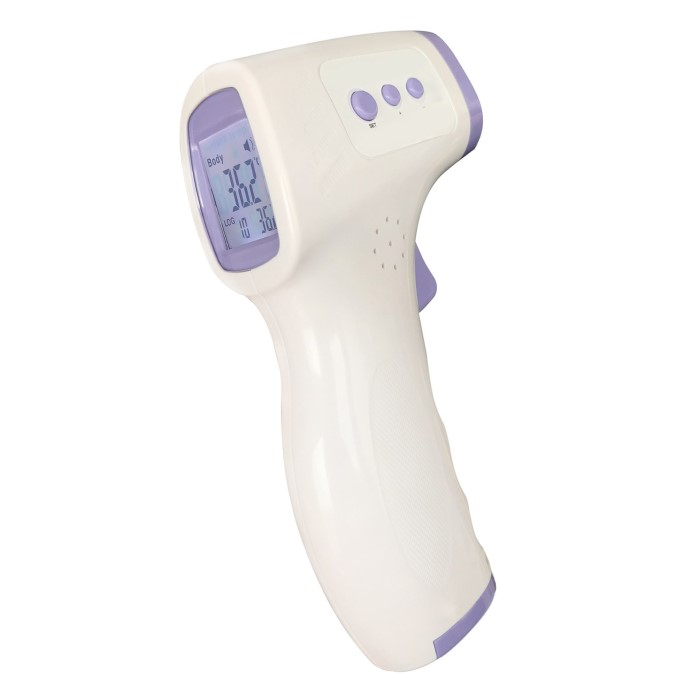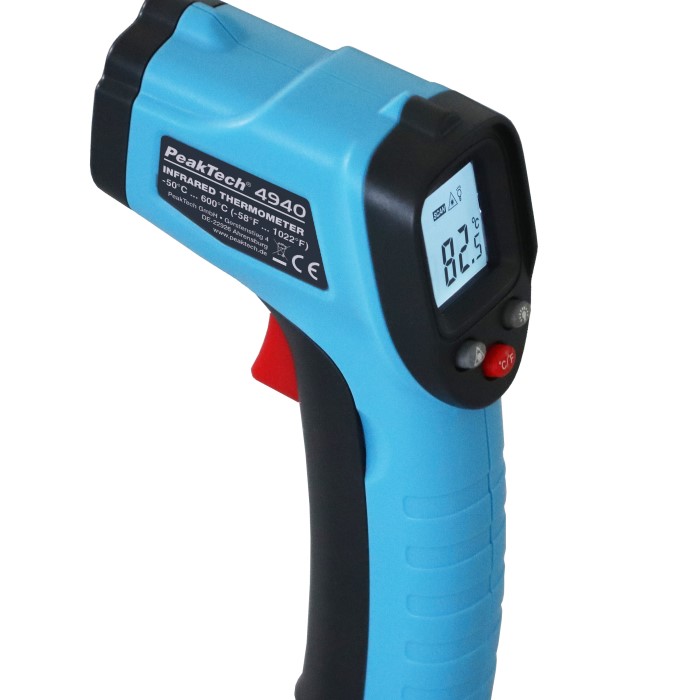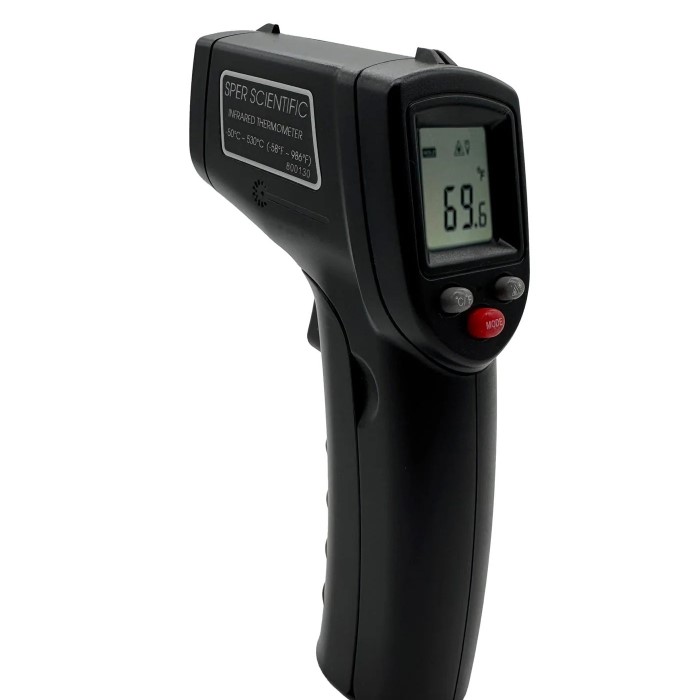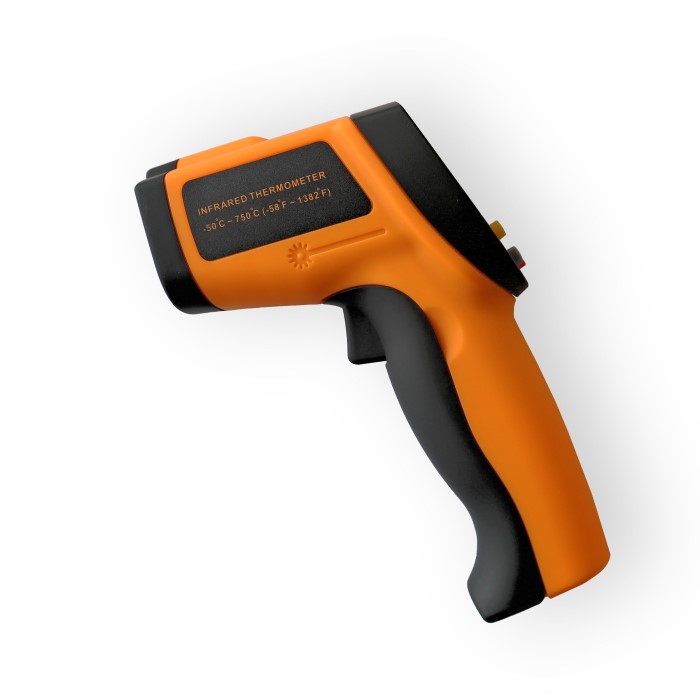What is a Digital Infrared Thermometer?
A digital infrared thermometer is a non-contact temperature measuring device. It detects infrared energy emitted by objects. These thermometers provide quick and accurate readings without physical contact. They are widely used across various industries, including medical, industrial, and food safety sectors.
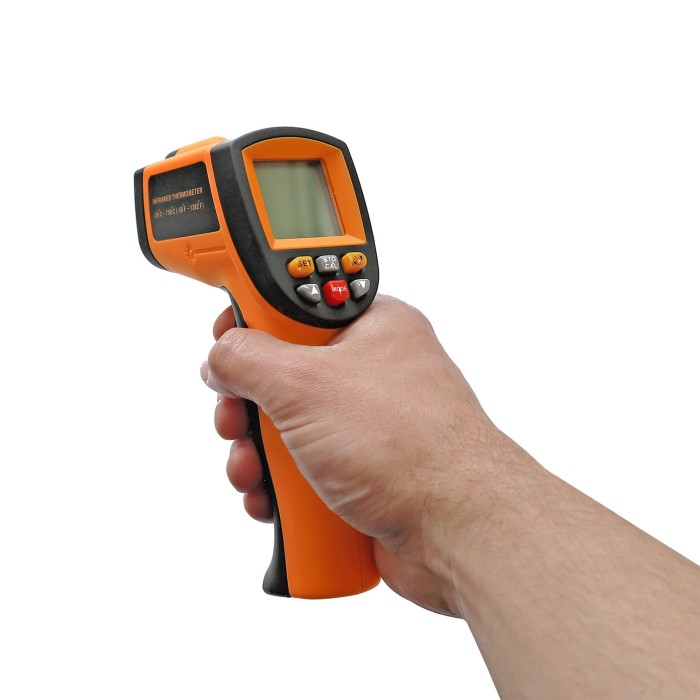
Key Features of Infrared Thermometers
- Non-Contact Measurement: Measures temperature without touching the object. This ensures hygiene and safety.
- Fast Readings: Provides results in seconds, making it highly efficient.
- Versatility: Works on various surfaces, including skin, metal, and liquids.
- High Accuracy: Delivers precise temperature readings with minimal error margins.
- User-Friendly: Simple design and easy-to-read digital displays.
- Wide Temperature Range: Can measure extreme temperatures, catering to diverse applications.
Types of Infrared Thermometers
- Handheld Infrared Thermometers: Portable and easy to use, suitable for general applications.
- Fixed Infrared Thermometers: Mounted on equipment, ideal for continuous monitoring in industries.
- Infrared Ear Thermometers: Designed specifically for medical use to measure body temperature.
- Dual-mode Thermometers: Can switch between infrared mode and traditional contact mode for versatility.
Understanding these features and types helps you choose the right device for your needs.
How Does a Digital Infrared Thermometer Work?
Digital infrared thermometers operate based on infrared radiation. They detect heat energy emitted by objects to measure temperature. This innovative mechanism allows for contactless and precise temperature readings.
The Science Behind Infrared Technology
Infrared thermometers work by sensing infrared waves. All objects emit these waves based on their temperature. A detector inside the thermometer absorbs these infrared waves. It then converts this energy into an electrical signal. The device processes the signal and calculates the temperature. The final readings appear on the digital display.
Infrared technology operates using the principle of blackbody radiation. This scientific concept explains how objects emit infrared energy. The intensity of emitted energy changes depending on the temperature of the object. Thermometers are calibrated to interpret this correctly, ensuring accurate results.
Key Components and Their Functions
Infrared Lens
-
- The infrared lens is a critical component that plays a central role in the functionality of the device.
- It focuses and collects infrared radiation emitted by the target object, ensuring that the thermometer measures the correct thermal energy.
- Designed to optimize the field of view, the lens helps capture a broader area, increasing measurement accuracy.
- The lens material is often selected for its ability to transmit infrared wavelengths efficiently, which enhances overall performance.
Detector
-
- The detector is responsible for converting the focused infrared radiation into an electrical signal.
- It usually consists of a sensing element made from specialized materials that respond to infrared radiation.
- This conversion process is crucial, as it transforms thermal energy into a form that can be interpreted by the device.
- The sensitivity of the detector greatly influences the accuracy and response time of the thermometer.
Processor
-
- The processor serves as the brain of the infrared thermometer, analyzing the electrical signal received from the detector.
- It employs algorithms to calculate the temperature accurately based on the intensity of the infrared radiation.
- The processing speed is essential for delivering quick and reliable temperature readings, enhancing the user experience.
- Advanced processors may also account for environmental factors, improving measurement reliability under varying conditions.
Digital Display
-
- The digital display provides a user-friendly interface by showing the measured temperature in a clear numeric format.
- It allows users to read results at a glance, ensuring that information is easily accessible and understandable.
- Many displays feature backlight options, making them usable in low-light conditions.
- Some advanced models may offer additional features on the display, such as temperature trends or alerts for abnormal readings.
Power Supply
-
- The power supply is fundamental to the operation of the infrared thermometer, providing the necessary energy for all components.
- Devices typically use batteries or rechargeable sources, making them portable and easy to use in various settings.
- Battery life is an important consideration, as longer-lasting batteries reduce the need for frequent replacements or charging.
- Some models may include low-battery indicators, alerting users to the need for a power source change, ensuring uninterrupted use.
These components work together seamlessly to provide rapid and reliable temperature readings. Understanding these elements helps users appreciate the technology and use the thermometer effectively.
Benefits of Using
Digital infrared thermometers offer numerous advantages, making them essential tools in various fields. Their efficient design and advanced technology provide unmatched convenience and reliability.
Accuracy and Speed
- Precise Measurements: Digital infrared thermometers ensure high accuracy with minimal error.
- Rapid Readings: Results are displayed in seconds, saving valuable time in critical situations.
- Consistent Performance: These devices offer reliable readings even with repeated use.
Contactless Measurement Advantages
- Hygienic Usage: No physical contact reduces contamination risks, especially in medical and food applications.
- Safe Distance Options: Measurements can be taken from a safe distance, enhancing user safety.
- Reduced Wear and Tear: Contactless operation ensures the device stays durable over time.
Applications Across Industries
- Medical Field: Used to quickly monitor patient temperatures with precision and care.
- Industrial Use: Ideal for checking machinery, detecting overheating, and ensuring operational safety.
- Food Safety: Ensures food is stored and cooked at optimal temperatures.
- Domestic Applications: Helpful for household tasks such as checking the temperature of appliances or room settings.
The versatility, accuracy, and ease of use make digital infrared thermometers indispensable tools for professionals and individuals alike.
Common Uses
Digital infrared thermometers are versatile tools. They are essential for applications across industries and households.
Medical Applications
Digital infrared thermometers are widely used in the medical field. They ensure contactless temperature measurements. Doctors use them to monitor patient temperature quickly and accurately. These thermometers help minimize contamination risks in hospitals and clinics. Infrared ear thermometers provide specific solutions for body temperature measurement. During pandemics, they are vital for fever screenings at public places.
Industrial and Maintenance Uses
Industries rely on infrared thermometers for safe and efficient operations. They monitor the temperature of machinery and equipment to prevent overheating. Technicians use them to detect faulty components and assess heat levels. In manufacturing, they verify the temperature stability during production. Infrared thermometers also ensure workplace safety by identifying heat-related risks.
Food Safety and Cooking
In food industries, infrared thermometers maintain quality and safety standards. They help check the temperature of stored and cooked items. Chefs use them to ensure perfect cooking temperatures for meals. They are ideal for measuring heat levels of ovens, grills, and food surfaces. By ensuring proper food temperatures, these devices prevent health hazards and maintain flavor quality.
Choosing the Right Infrared Thermometer
Selecting the right digital infrared thermometer ensures accurate and reliable measurements. Various factors must be considered.
Factors to Consider When Buying
- Accuracy: Look for thermometers with minimal error margins for precise readings.
- Measurement Range: Ensure the device covers the temperature range you require.
- Response Time: Choose one with fast reading capabilities for efficiency.
- Durability: Select thermometers with robust construction suitable for your environment.
- Size and Design: Opt for a model that is easy to handle and read.
- Special Features: Consider added functions like dual-mode options or adjustable emissivity.
- Industry-Specific Use: Check if the thermometer suits your specific application, like medical or industrial use.
Balancing these factors will help find a suitable thermometer for your needs.
Comparison of Popular Models
FLIR TG165 Spot Thermal Camera
-
- This camera is specifically designed for industrial applications, making it an excellent choice for professionals in various fields.
- It features a broad temperature measurement range, allowing users to capture temperatures in a wide array of environments and conditions.
- The image capture capabilities enable users to visualize heat patterns and identify thermal anomalies effectively.
- Its robust construction ensures durability, even in challenging industrial settings, enhancing its reliability for everyday use.
Braun ThermoScan 7
-
- This thermometer is tailored for medical applications, focusing on providing accurate temperature readings for patients.
- It employs innovative technology to deliver precision measurements, which is critical in clinical settings.
- The gentle ear temperature measurement design ensures patient comfort, making it ideal for children and infants.
- Its user-friendly interface allows quick operation, making it suitable for both healthcare professionals and home users.
Etekcity Lasergrip 800
-
- This infrared thermometer is ideal for home use, providing an affordable option without sacrificing quality.
- It offers versatility in measuring a variety of surfaces, such as food, water, and appliances, making it a valuable tool in everyday situations.
- The easy-to-read display ensures that measurements are clear and straightforward, enhancing user experience.
- Its lightweight and portable design make it convenient for quick temperature checks around the house or during outdoor activities.
ThermoPro TP30
-
- Recognized for its rapid measurement capabilities, the ThermoPro TP30 is an excellent choice for those concerned about food safety and cooking.
- It delivers quick and accurate temperature readings, allowing users to ensure that food is cooked to the right temperature.
- The device is also suitable for other applications, such as monitoring liquid temperatures, enhancing its usability in kitchen settings.
- Its straightforward design ensures that anyone can use it effectively, whether a professional chef or a home cook.
Klein Tools IR1
-
- This infrared thermometer is built to be sturdy, making it suitable for maintenance tasks across various industries.
- Known for its reliable performance, it provides consistent and trustworthy temperature readings, which is crucial for accurate troubleshooting.
- The device’s rugged construction allows it to withstand harsh working conditions, ensuring longevity and durability.
- Its practical features cater to professionals needing a dependable tool for electrical, HVAC, and other maintenance duties.
These models cater to diverse purposes, ensuring efficient and accurate temperature measurements across sectors.
Tips for Proper Use and Maintenance
Proper use and maintenance of digital infrared thermometers ensure long-term accuracy and functionality. Following best practices will help maximize the device’s performance.
Best Practices for Accurate Readings
- Ensure Proper Calibration: Regularly calibrate the thermometer to maintain reliable and accurate readings.
- Use the Correct Settings: Adjust the emissivity settings to match the target object’s material.
- Keep Distance Consistent: Measure from the recommended distance provided by the manufacturer.
- Avoid Obstructions: Ensure no objects block the infrared path during measurement.
- Choose the Right Environment: Avoid extreme humidity or reflective surfaces that might affect accuracy.
- Verify with Known Temperatures: Test the thermometer against a standard temperature source periodically.
Cleaning and Storage Guidelines
- Clean the Lens Safely: Use a soft cloth to avoid scratches and maintain lens efficiency.
- Avoid Harsh Chemicals: Clean the device with mild solutions to prevent damage.
- Store in a Dry Place: Keep the thermometer away from moisture and extreme temperatures.
- Protect Against Dirt: Use a protective case to ensure the device remains dust-free.
- Maintain Battery Health: Remove batteries when not in use for extended periods.
- Follow Manufacturer Instructions: Always refer to the device manual for specific cleaning and storage recommendations.
Adhering to these tips helps preserve the thermometer’s functionality and ensures accurate temperature measurements over time.
Safety and Limitations of Infrared Thermometers
Digital infrared thermometers are powerful tools but come with certain safety aspects and limitations. Users should be aware of these factors for effective and safe use.
Understanding Precautions
- Avoid Direct Eye Contact: Never point the laser at anyone’s eyes. It can cause serious eye injury.
- Check for Compatibility: Ensure the thermometer suits the surface or object you are measuring.
- Be Aware of Reflective Surfaces: Reflections may distort readings and affect accuracy.
- Follow Manufacturer Guidelines: Carefully read instructions to avoid misuse and ensure accurate readings.
- Keep the Device Away from Children: These thermometers are not toys and require supervision when used.
- Protect from Extreme Conditions: Don’t expose the device to high temperature, moisture, or harsh chemicals.
Adhering to these precautions guarantees safe operation and extends the device’s lifespan.
Situations Where Infrared Thermometers May Not Work Effectively
- Highly Reflective Materials: Surfaces like polished metals can lead to inaccurate readings.
- Thick or Dense Objects: Infrared rays cannot penetrate thick materials, limiting internal temperature measurement.
- Rapidly Changing Temperatures: These thermometers might struggle with environments where temperatures fluctuate quickly.
- High Humidity: Moisture in the air may interfere with the thermometer’s sensor.
- Non-Uniform Heat Distribution: Devices may fail to detect uneven temperatures across an object’s surface.
- Improper Calibration: Lack of proper calibration can result in false readings, reducing device reliability.
Understanding these limitations ensures users know the right situations to use these thermometers. This knowledge helps avoid errors while maintaining device accuracy and efficiency.
Frequently Asked Questions
How Accurate Are Digital Infrared Thermometers?
Digital infrared thermometers are designed to deliver high accuracy. Their precision depends on proper usage and calibration. Most models have an error margin of 1-2 degrees, which is minimal. Factors like emissivity settings and measurement distance affect accuracy. Follow manufacturer guidelines for reliable readings. For optimal results, always test the thermometer against a known temperature source.
Can They Be Used on All Surfaces or Objects?
Digital infrared thermometers work well on most surfaces but have limitations. They excel at measuring skin, food, metal, and liquid temperatures. Highly reflective surfaces like polished metals can cause errors. Dense or thick materials may not allow infrared radiation to penetrate. Use adjustable emissivity settings to measure difficult surfaces accurately. Always verify compatibility with the object or material before use.
Conclusion
In summary, a digital infrared thermometer is a powerful tool for monitoring health at home. Its non-invasive design, speed, and versatility make it suitable for various applications beyond healthcare. By understanding how it works, selecting the right model, and maintaining it properly, you can enhance health monitoring for your family effectively. Incorporating this technology into your home promotes a proactive approach to health and wellness.
Incorporate digital infrared thermometer into your household to effortlessly monitor health and respond to potential issues swiftly. Their benefits and ease of use make them an essential addition to any home health toolkit.
